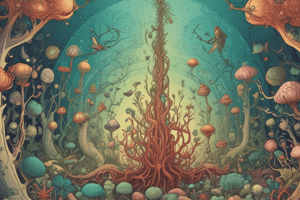Podcast
Questions and Answers
Which of the following best describes the function of palisade cells within a leaf?
Which of the following best describes the function of palisade cells within a leaf?
- Regulating water loss through the cuticle.
- Facilitating gaseous exchange via stomata.
- Providing structural support to the leaf veins.
- Optimizing light absorption for photosynthesis. (correct)
How do guard cells contribute to the process of photosynthesis in plants?
How do guard cells contribute to the process of photosynthesis in plants?
- By transporting glucose produced during photosynthesis to other plant parts.
- By providing a protective layer around the chloroplasts.
- By controlling the opening and closing of stomatal pores for gas exchange. (correct)
- By directly absorbing water from the soil.
What happens to the glucose created during photosynthesis?
What happens to the glucose created during photosynthesis?
- It is released directly into the atmosphere as a byproduct.
- It is stored as starch and then transported to other parts of the plant. (correct)
- It is immediately converted into proteins for plant growth.
- It is used to break down excess water in the plant cells.
What is the role of xylem in the context of photosynthesis?
What is the role of xylem in the context of photosynthesis?
Which of the following best explains why plants require nutrients like nitrogen, phosphorus, and magnesium, in addition to carbon dioxide and water?
Which of the following best explains why plants require nutrients like nitrogen, phosphorus, and magnesium, in addition to carbon dioxide and water?
If a plant cell lacks sufficient water and the guard cells shrink, what is the most likely outcome?
If a plant cell lacks sufficient water and the guard cells shrink, what is the most likely outcome?
In the context of plant nutrition, what distinguishes autotrophic organisms from heterotrophic organisms?
In the context of plant nutrition, what distinguishes autotrophic organisms from heterotrophic organisms?
Which of the following best describes chemosynthetic nutrition?
Which of the following best describes chemosynthetic nutrition?
What role do carbohydrates play in providing energy to cells?
What role do carbohydrates play in providing energy to cells?
What is the term for living organisms which are alive?
What is the term for living organisms which are alive?
Flashcards
Photosynthesis
Photosynthesis
The process by which green plants prepare food using sunlight, chlorophyll, inorganic substances, carbon dioxide, and water. Oxygen is released.
Chloroplasts
Chloroplasts
Plant cell organelles where photosynthesis takes place. They contain a green pigment called chlorophyll.
Stomata
Stomata
Tiny pores on leaves for gaseous exchange. CO2 enters for photosynthesis, O2 is released.
Guard Cells
Guard Cells
Signup and view all the flashcards
Plastids
Plastids
Signup and view all the flashcards
Nutrition
Nutrition
Signup and view all the flashcards
Food
Food
Signup and view all the flashcards
Respiration
Respiration
Signup and view all the flashcards
Excretion
Excretion
Signup and view all the flashcards
Locomotion
Locomotion
Signup and view all the flashcards
Study Notes
What are Life Processes?
- All living organisms perform some basic functions to keep themselves alive, known as life processes.
- Life processes include nutrition, respiration, transportation, excretion, control and co-ordination, growth, locomotion and reproduction.
Similarities Between Living and Non-living Things
- Living things and non-living things are made up from the same elements.
- The elements comprise living and non-living things combine to form molecules (biomolecules in living beings).
- Molecules of both living and non-living objects can interact.
Studying That Suits You
Use AI to generate personalized quizzes and flashcards to suit your learning preferences.




